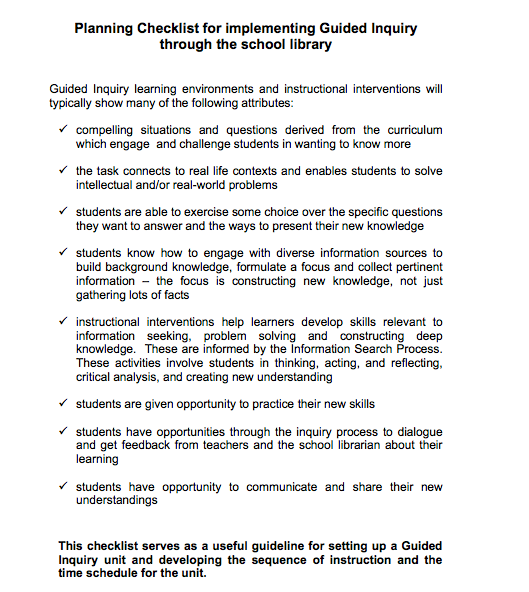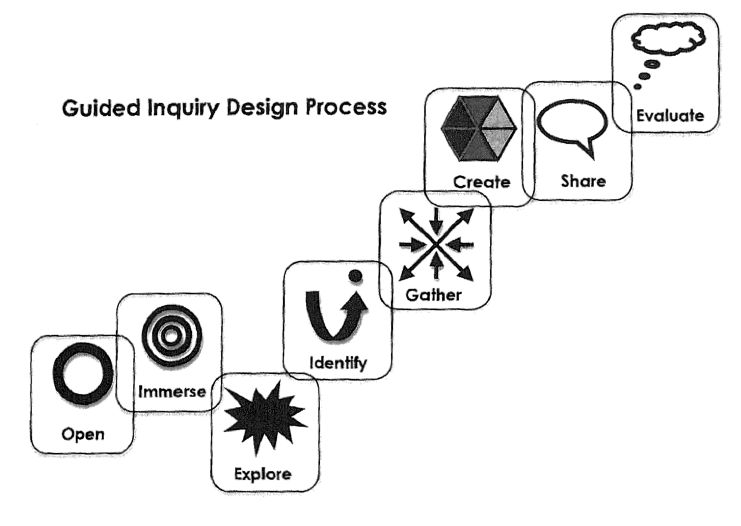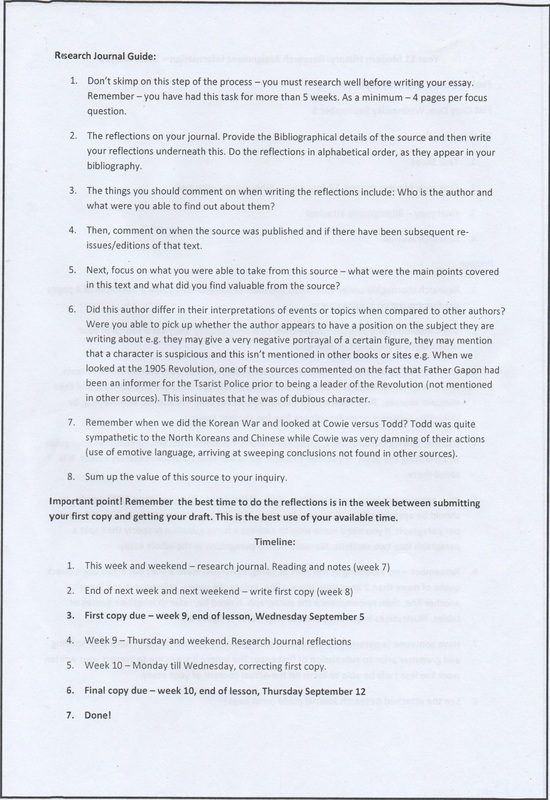Whilst the ILA has strong links to inquiry based learning (as seen in the analysis section), several steps can be taken to enhance guided inquiry. One of the main concerns uncovered during the ILA, was that no specific guided inquiry models were used and that guided inquiry can be enhanced by partnerships between classroom teachers, the school librarian and the school community (Todd, Kuhlthau, & Heinström, 2005, p. 12). School librarians are able to “bring their information-learning expertise of knowing how students engage in seeking and using information guided by the Information Search Process” (Todd, Kuhlthau, & Heinström, 2005, p. 12). Some important questions that should be addressed by classroom teachers and school librarians as noted in the School Library Impact Measure (Todd, Kuhlthau, & Heinström, 2005, p. 13) include:
For the most part it was noted that during the ILA the teacher had structures in place to guide students through their learning processes and to address issues arising during students’ assignment period. However in order to take the ILA to the next level students need to be more aware of ISPs and the needs to consciously teacher develop meaningful inquiry based lessons and assessments.
The School Library Impact Measure (SLIM) was designed to assess students’ learning through guided inquiry specifically in the school library. The toolkit outlines the characteristics of guided inquiry and the information search process (ISP) and provides a checklist for implementing guided inquiry through the school library.
- How do I guide students in their inquiry?
- When do I intervene?
- What is the nature of the intervention in terms of intellectual and affective scaffolds for enabling inquiry?
- How do I enable students to stay focused and not be distracted from the learning task at hand?
- How do I motivate and engage students who may perceive the search task as primarily one of gathering information to a task of forming a focused perspective from the information encountered?
- How do I know what learning has taken place?
- How do I foster ongoing learning?
For the most part it was noted that during the ILA the teacher had structures in place to guide students through their learning processes and to address issues arising during students’ assignment period. However in order to take the ILA to the next level students need to be more aware of ISPs and the needs to consciously teacher develop meaningful inquiry based lessons and assessments.
The School Library Impact Measure (SLIM) was designed to assess students’ learning through guided inquiry specifically in the school library. The toolkit outlines the characteristics of guided inquiry and the information search process (ISP) and provides a checklist for implementing guided inquiry through the school library.
By introducing students to ISP models it would make them more aware of the steps involved in research and information gathering. If students were more aware of how guided inquiry can help their research gathering and essay writing skills I think they would pay more attention to the research journal and how this can help them with their assignments.
Bloom’s taxonomy of learning
The revised Bloom’s Taxonomy provides a useful framework for the design and development of guided inquiry learning.
Bloom’s taxonomy of learning
The revised Bloom’s Taxonomy provides a useful framework for the design and development of guided inquiry learning.
- Remembering: Retrieving, recognizing, and recalling relevant knowledge from long-term memory.
- Understanding: Constructing meaning from oral, written, and graphic messages through interpreting, exemplifying, classifying, summarizing, inferring, comparing, and explaining.
- Applying: Carrying out or using a procedure through executing, or implementing.
- Analysing: Breaking material into constituent parts, determining how the parts relate to one another and to an overall structure or purpose through differentiating, organizing, and attributing
- Evaluating: Making judgments based on criteria and standards through checking and critiquing.
- Creating: Putting elements together to form a coherent or functional whole; reorganizing elements into a new pattern or structure through generating, planning, or producing.
Bloom’s Taxonomy enables students to develop their higher level thinking skills and provides a framework for teachers to ensure they are teaching the necessary skills in class lessons and during assessment periods. For the most part Bloom's Taxonomy was evident at the ILA. However students need to become more aware of the specific processes involved in learning for them to feel more connected. Quire often students go through the motions of assessments with out understanding how specific techniques or learning processes will benefit them in the future. Specific attention should also be paid to the analysing and evaluating section, as it was revealed that a large portion of the students at the ILA did not understand the significance of the Research Journal. Students need to understand the importance of gathering information and being able to analyse and evaluate for validity, relevance and credibility. This is one area that needs to be improved at the ILA. By introducing Bloom's Taxonomy and making students aware of the processes and how they all work together, this will enhance guided inquiry within the ILA.
Guided Inquiry Design Process
As a result of examining Kuhlthaus’s Guided inquiry Design Process, it is recommended that the assessment piece be altered. Instead of producing one large essay at the end, the assignment could be the culmination of several short responses with an annotated bibliography for each. This could be undertaken in the form of a blog, which would also require peer feedback and ongoing assessment and reflection on their assessment. It would also ensure that students were writing their research journal (or annotated bibliography) at the time of research. The blog could also include more inquiry-based tasks such as primary source analysis. A blog would enable students to be more connected to the research section of their essay as they wouldn’t just be producing one large research journal at the end of their assessment, rather they would have to be undertaking this process along the way. Peer feedback would enable students to monitor their progress and would also enable them to correct any errors.
Blogging enables students to delve more deeply into metacognitive engagement within their learning program (O’Connell & Groom, 2010, p. 23). Which would further enhance students’ information search processes. Furthermore I also came across Siemen’s article (2004) on designing learning experiences around the connectivism theory, whereby students are continually changing their perceptions as they discover more information and develop a deeper knowledge through critical inquiry based learning and access to web 2.0 tools such as blogs.
One aspect that would greatly increase the guided inquiry approach within the ILA is that of reflective writing. O’Connell & Groom (2010, p.20) state, “Reflective writing facilitates sorting of knowledge, ideas, feelings and understandings as a continuum of questioning and knowledge aggregation.” By assessing students on a reflective piece it would enable them to think critically about their work and how they came to a set conclusion. More importantly it allows students to draw connections between what is known and what is being learned and to take control of their learning in order to monitor and make improvements when necessary (O’Connell & Groom, 2010, p.20). The evaluation process is an important step within guided inquiry and Bloom’s taxonomy as when students are able to critically reflect on their learning processes this enables them to further develop as an independent learner. Significant thought has gone into this online unit of work, to ensure that students are engaged in flexible and collaborative learning experiences. The blended learning approach, through the use of student’s individual blogs and traditional based teaching methods, would enable students to be involved in inquiry based learning and to continually reassess their positions and knowledge with regards to the ILA.
Blogging enables students to delve more deeply into metacognitive engagement within their learning program (O’Connell & Groom, 2010, p. 23). Which would further enhance students’ information search processes. Furthermore I also came across Siemen’s article (2004) on designing learning experiences around the connectivism theory, whereby students are continually changing their perceptions as they discover more information and develop a deeper knowledge through critical inquiry based learning and access to web 2.0 tools such as blogs.
One aspect that would greatly increase the guided inquiry approach within the ILA is that of reflective writing. O’Connell & Groom (2010, p.20) state, “Reflective writing facilitates sorting of knowledge, ideas, feelings and understandings as a continuum of questioning and knowledge aggregation.” By assessing students on a reflective piece it would enable them to think critically about their work and how they came to a set conclusion. More importantly it allows students to draw connections between what is known and what is being learned and to take control of their learning in order to monitor and make improvements when necessary (O’Connell & Groom, 2010, p.20). The evaluation process is an important step within guided inquiry and Bloom’s taxonomy as when students are able to critically reflect on their learning processes this enables them to further develop as an independent learner. Significant thought has gone into this online unit of work, to ensure that students are engaged in flexible and collaborative learning experiences. The blended learning approach, through the use of student’s individual blogs and traditional based teaching methods, would enable students to be involved in inquiry based learning and to continually reassess their positions and knowledge with regards to the ILA.
References
Kuhlthau, Carol C. ; Maniotes, Leslie K. & Caspari, Ann K, Guided inquiry : learning in the 21st century, (pp.13 – 28). Westport, Conn: Libraries Unlimited.
O'Connell, Judy and Groom, Dean. (2010). Chapter 3 : Writing and Reflecting in O'Connell, Judy and Groom, Dean, Connect, communicate, collaborate : learning in a changing world, Camberwell: ACER, pp.20 - 30.
Queensland Studies Authority (QSA). (2004). Senior Modern History Syllabus. Queensland Studies Authority, Queensland.
Siemens, G. (2004). Connectivism: A learning theory for the digital age. elearnspace. Accessed April 22, 2008 from http://www.elearnspace.org/Articles/connectivism.htm
Todd, R. J., Kuhlthau, C. C., & Heinström, J. E. (2005). School Library Impact Measure (SLIM): A Toolkit and Handbook for Tracking and Assessing Student Learning Outcomes of Guided Inquiry through the School Library. Center for International Scholarship in School Libraries, Rutgers University. Retrieved from http://leadinglibrariesprimary.files.wordpress.com/2011/03/slim_toolkit-handbook.pdf




